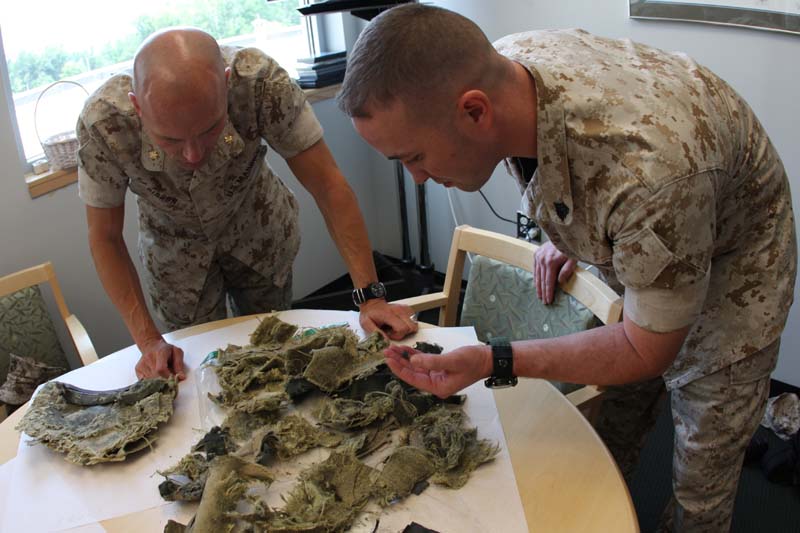Drexel and Army Research Lab Forge a Partnership

- Drexel Selects New, World-Class Life Sciences Building at 3201 Cuthbert Street for Medical Research Operations
- Breakthrough on Gene Therapy for Hereditary Spastic Paraplegia
- Drexel Environmental Collaboratory Releases Cross-Sector Findings on Severe Weather Recovery Challenges
- Drexel Launches the Manuel Stamatakis Center for Alternative Investments at the LeBow College of Business

Drexel researchers will work with scientists from the Army Research Lab to solve a variety of scientific and technological challenges.
Drexel University researchers will now have the opportunity to work alongside scientists from the Army Research Lab — the Army's central laboratory. The institutions recently signed an agreement that formally connects Drexel with ARL Open Campus research initiative. With this agreement, the University strives to engage a diverse and wide-ranging network of faculty in collaborative efforts with ARL entities.
“This opportunity to collaborate in a formal partnership provides Drexel’s faculty and students from numerous disciplines, with the ability to conduct collaborative, fundamental and applied research with experts from the Army Research Laboratory,” said Aleister Saunders, PhD, senior vice provost for research.
Under the Cooperative Research and Development Agreement, Drexel will join ARL's Open Campus program, which means researchers from across the university will have access to ARL scientists and research facilities. And, in return, ARL scientists will have the opportunity to come on campus and work with Drexel researchers. The partnership with Drexel is one of about 180 formal research agreements that the federal government has with non-government and university partners. The bulk of Drexel’s work with ARL will take place at Aberdeen Proving Ground in Maryland.
“ARL’s Open Campus business model creates a dynamic, cooperative science and technology ecosystem that links government assets with the global research community,” said Thomas Mulkern, chief of the ARL Technology Transfer Office. "Open Campus partners work side-by-side with ARL research scientists and engineers to share ARL’s specialized research facilities and bring ARL researchers to their institutions to communicate a perspective on research conducted in federal laboratories, and become part of the broader DOD network. ARL is opening areas of its Adelphi Laboratory Center and APG to host visiting scientists and engineers, including foreign nationals. We envision future construction of new facilities to host partners with laboratory and office space to serve academia and small businesses, and to incubate entrepreneurial startups."
One of the first collaborations will be between the ARL's Vehicle Technology Directorate — the branch of the lab that studies mobility-related science and technologies in search of advanced capabilities and improved reliability for Army air and ground vehicles — and Drexel mechanical engineers working at the forefront of advanced, non-destructive structural testing.
"Our initial project addresses the U.S. Army Research Laboratory Sciences for Maneuver Campaign's desire to identify damage on Army aircraft due to metal fatigue and stress — finding out where and when faults may occur before it becomes critical, which is known as finding damage precursors," said Antonios Kontsos, PhD, a professor in the College of Engineering, who heads the Theoretical & Applied Mechanics Group.
Kontsos’s lab has pioneered new methods for using sound and light to study structural integrity and quantify fatigue and fracture damage without affecting the structure itself. The group has applied its technology to inspect buildings, bridges and other infrastructure in affected areas of New Jersey in the aftermath of Hurricane Sandy. Deploying the sensing equipment via drones and other aircraft allowed the team to examine large structures without further damaging them or putting themselves in harm’s way. This strategy could lend itself to equipment monitoring in the battlefield, according to Kontsos.
“The Army will work closely with Drexel’s team lead by Professor Antonios Kontsos to formally address modeling approaches that can inform about the severity of damage precursors in aviation structures. The partnership also creates new experiential learning opportunities for students and connects them to career opportunities within the Department of Defense,” said Dy D. Le, chief of ARL-VTD’s Mechanics Division.
Under the agreement, researchers from across the University will have the opportunity to contribute to ARL’s research thrusts. It will also create a pipeline for students to work directly with the Laboratory in funded research and co-op positions.
“The agreement instantly expands our research capabilities and provides a defined administrative framework for our involvement in mission-oriented research and development,” Saunders said. “The partnership also creates new experiential learning opportunities for students and connects them to career pathways within the Department of Defense.”
A ceremony to formally announce the partnership will be held in June. Information sessions will take place at Drexel over the next several months to help connect the research community with the opportunities provided by this partnership. Interested researchers can also email ARL.CRADA@drexel.edu to learn more.
In This Article
Contact
Drexel News is produced by
University Marketing and Communications.